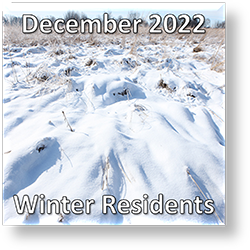 Surviving an Illinois winter is a difficult challenge for wildlife species. Some animals cannot meet the challenge and travel away from Illinois for winter. Some bats, birds and insects migrate out of our state for winter. Those animals that spend the winter in Illinois must be able to survive the following conditions: short periods of daylight; cold temperatures; possible lack of accessible water; and possible difficulty in finding food.
Surviving an Illinois winter is a difficult challenge for wildlife species. Some animals cannot meet the challenge and travel away from Illinois for winter. Some bats, birds and insects migrate out of our state for winter. Those animals that spend the winter in Illinois must be able to survive the following conditions: short periods of daylight; cold temperatures; possible lack of accessible water; and possible difficulty in finding food.
Animals in Illinois that cannot travel long distances live here all year. Other animals in Illinois are capable of moving long distances to more suitable winter conditions, but they do not. Some animals even move into Illinois to spend the winter. How do these winter residents survive?
Hibernation
Some of them hibernate. Hibernation is a period of inactivity and drastic reductions in bodily functions, such as body temperature, heart and breathing rates.
The
woodchuck (Marmota monax) is an example of a true hibernator. Prior to the hibernation period, it accumulates a thick layer of body fat that will supply it with the energy needed to survive. It will not eat other food during hibernation and may lose as much as one-third of its total body weight. This animal may spend five or six months of the year hibernating in its underground burrow. The woodchuck is one of several mammal species in Illinois that hibernate. The food sources (insects, plants) for these animals are not available during winter.
Reptiles hibernate. They may move to a safe location to hibernate such as a crevice in a rock cliff, a cavity in a rotting log or under a rock. Land-based turtles dig a burrow to hibernate in. Aquatic turtles go to the bottom of a water body where they may bury themselves entirely or partially in the mud and plant debris. The temperature of water, especially in a large water body, is slow to change. The temperature of air changes quickly. Turtles and other aquatic hibernators benefit from the minimal fluctuation in water temperature, especially at the bottom of a water body. Cold water also contains more oxygen than warm water. Turtles normally use lungs to breathe, but when hibernating they use special cells in their throat and cloaca to absorb oxygen from the water and release wastes from their blood.
Aquatic frogs, like the
American bullfrog (Lithobates catesbeianus), spend the winter at the bottom of a water body. They may be partially buried in mud, but they need contact with the water to breathe through their skin. Land-based frogs that can dig, like the
American toad (Anaxyrus americanus), bury themselves in the ground below the freeze line. Terrestrial frogs that can't dig well, such as the
wood frog (Lithobates sylvaticus) and
spring peeper (Pseudacris crucifer), find shelter in a hollow log, tree cavity or in leaf litter. These frogs may actually partially freeze. However, their body organs contain high levels of glucose that acts like antifreeze. The frog may stop breathing, and its heart may not beat, but it is not dead.
Some insects, including some adult butterflies, hibernate. The
mourning cloak (Nymphalis antiopa) is an example. It finds shelter for the winter in a hollow log or a tree cavity. Immature stages in the life cycle (egg, larva, chrysalis) are the means of survival for most insects with the majority of adult insects dying in the fall of the year. In insects such as hornets and bumblebees, only the queens survive the winter, hibernating in the ground. They will emerge in the spring and lay eggs to begin new colonies.
Dormancy
Dormancy, or inactivity, is another method used for winter survival. Dormancy allows animals to conserve energy and survive periods of limited food supply.
Striped skunks (Mephitis mephitis) and
raccoons (Procyon lotor), for instance, “den up” during extremely cold weather, remaining in their burrow or den and living off excess body fat, while not actually hibernating. Tree squirrels stay in their nest or a tree cavity when weather conditions are harsh. They cache nuts and acorns in the fall as available food for winter.
Other Options
The
eastern cottontail (Sylvilagus floridanus) is a mammal that is active year-round but may change its diet if heavy snowfall is present and its normal food sources cannot be accessed.
White-tailed deer (Odocoileus virginianus) may gather in upland forests or shrubby areas in severe winters. These locations may have less snow and more shelter and food than their normal habitat. Otherwise, they tend to stay in the same areas throughout the year, varying their diet as their food sources change.
Mammals add additional fur in winter.
Birds produce feathers that help them conserve heat. They can fly to escape unfavorable conditions, if needed.
Cave salamanders may remain active in winter since the temperature in the cave and their food sources remain fairly constant throughout the year.
Fishes and aquatic salamanders slow their activity during winter. Some species migrate to larger bodies of water or areas of calmer water before winter to increase their chances of survival.
No matter which method is used, winter survival is not guaranteed. If the freeze line reaches or goes below a hibernating animal, it may die. If a body of water freezes to the bottom, the animals in it will die. If snow or ice covers the food sources for animals for an extended period of time, they may die if they cannot move to more favorable areas. Even with all of the challenges of winter, some animals will survive and start the cycle of life again in spring.

